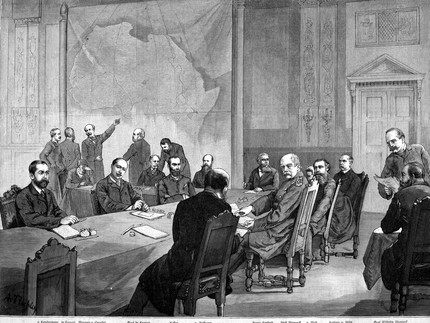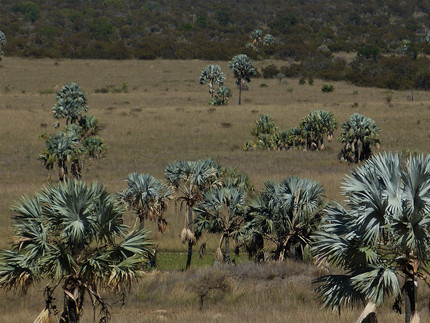Berlin Africa Conference without the presence of Africans
In the course of high imperialism, a so-called "race for Africa" (also referred to as the "scramble for Africa") by the European powers began.1,2 At the Berlin Africa Conference (1884/85), among other things, binding rules were drawn up for the further division of Africa and the future of the Congo Basin was decided.1 The pretended "civilizing mission" was in open contradiction to colonial rule practices, which were characterized by violence, forced labor, racism, and disregard for the rights of the indigenous population.2,3
However, the division of Africa began before the conference and was basically only confirmed in Berlin - regardless of African interests as well as African contexts of rule and social structures.3,4 Colonial border demarcations diverted developments, hindered them, produced new regional identities, and caused losers of colonialism. Colonial borders became the basis of post-colonial state foundations and are largely still valid today.3
Otto von Bismarck (1.4.1815 - 30.7.1898) was originally a clear opponent of German "colonial ownership." However, as Chancellor of the Reich, he was responsible for the formal declaration of German colonies in Africa in 1884/85. He was also the initiator of the Berlin Conference.1
Bismarckias (there is only one species), with their steel-gray fan leaves, are very remarkable palms and therefore valued as ornamental trees in the tropics to this day.
References
[1] Zimmerer, Jürgen (2015): Bismarck und der Kolonialismus: Bundeszentrale für politische Bildung (Aus Politik und Zeitgeschichte, 65. Jahrgang). In: 13/2015
. Online verfügbar unter www.bpb.de/shop/zeitschriften/apuz/202991/bismarck/, zuletzt geprüft am 11.02.2023.
[2] Carpus e. V. (Hg.) (2017): Kolonialrassismus und Widerstand. Globales (Geschichts-)Lernen in Berlin, Dresden, Leipzig und Potsdam. 1. Auflage. Online verfügbar unter leipzig-postkolonial.de/wp-content/uploads/2021/04/Kolonialrassismus-und-Widerstand-Broschuere-2017-1.pdf, zuletzt geprüft am 08.02.2023.
[3] Eckert, Andreas (2009): 125 Jahre Berliner Afrika-Konferenz. Bedeutung für Geschichte und Gegenwart. In: GIGA Focus Africa
(12). Online verfügbar unter www.ssoar.info/ssoar/handle/document/27459, zuletzt geprüft am 10.02.2023.
[4] Eckert, Andreas (2013): Die Berliner Afrika-Konferenz (1884/85). In: Jürgen Zimmerer und Marianne Bechhaus-Gerst (Hg.): Kein Platz an der Sonne. Erinnerungsorte der deutschen Kolonialgeschichte. Frankfurt: Campus Verlag.


